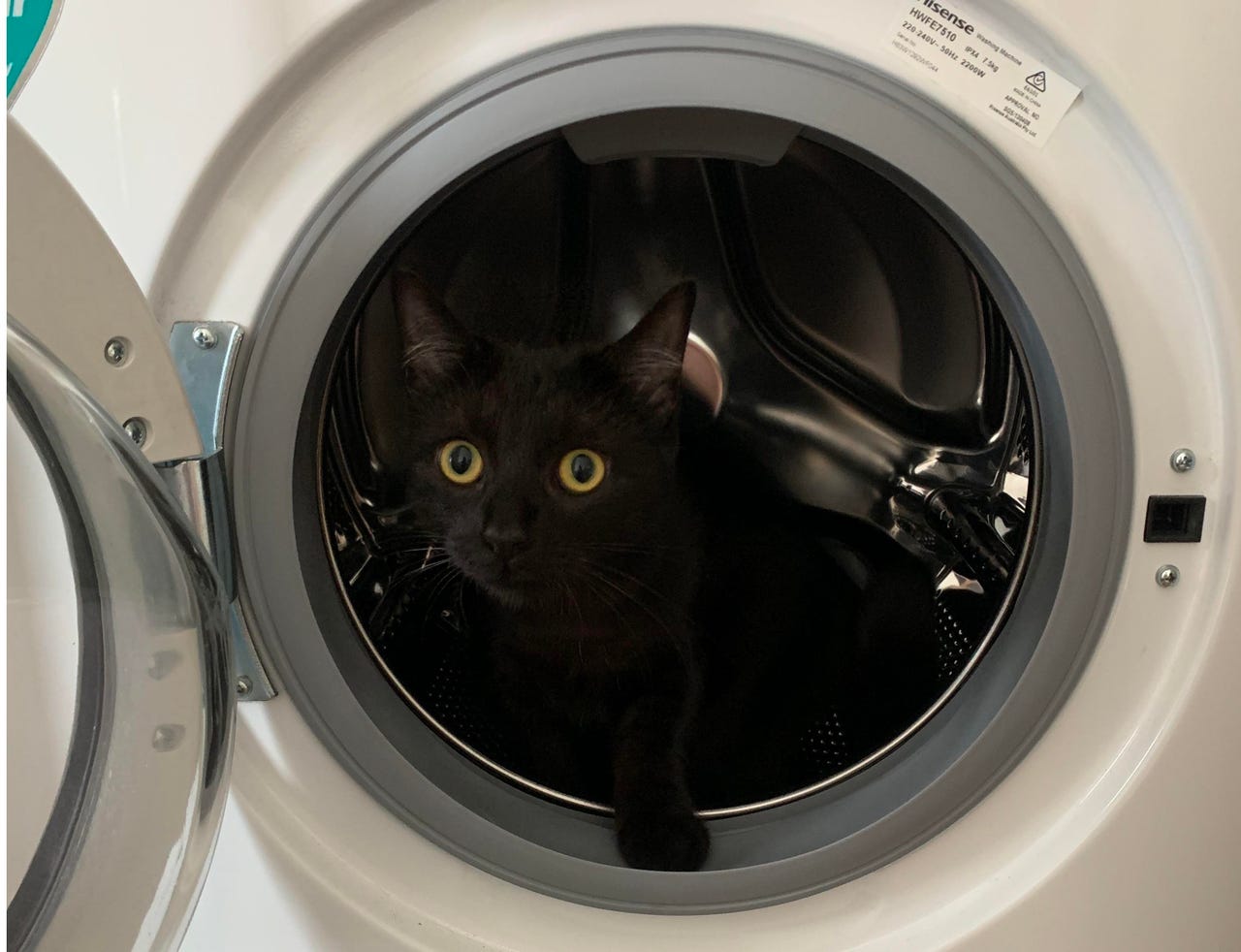CSIRO's Data61 and Ceres Tag to develop smart satellite-linked pet tracking collar

ZDNet Australia's cat Boston emerging from his space ship for snacks.
The Commonwealth Scientific and Industrial Research Organisation's (CSIRO) Data61 has partnered with agtech firm Ceres Tag to develop a prototype smart collar to enable pet owners to track and locate their animals in real-time.
Dubbed as the companion collar, the prototype will use a combination of Data61's embedded intelligence platform and Bluetooth technology to track the location of their pet within an established boundary, such as inside the home, but it will automatically switch to GPS location and satellite communications when the pet wanders outside of network. The information is fed to the owner in real time via an app.
According to Data61 senior research engineer Phil Valencia, unlike other smart trackers, this prototype will use a combination of technologies, rather than just the one, plus it will not require a mobile plan.
"Many devices only employ Bluetooth or Wi-Fi-based tracking, which often involve a community of people listening' on their phones and sharing their location data with a service in order to report the tracking device. This method is also only suitable for short distance monitoring," he said.
At the same time, Valencia said the collar will also be able to monitor a pet's behaviour, out of the ordinary activity, and health metrics data.
"Owners will get valuable insights into how their pet has behaved throughout the day, with the system identifying if the animal's activity is above or below its typical levels, and whether it was significantly different at a certain time of day," he said.
The prototype builds on existing work between CSIRO and Ceres Tag where the pair have developed smart ear tags (e-tags) for tracking livestock, such as cattle, to give farmers greater transparency. The smart e-tags are expected to be a commercially viable product by early 2021.
Ceres Tag chief operating officer Lewis Frost believes the collar, much like the e-tag, has the potential to improve the health and welfare of domestic animals.
"Ceres is leveraging all its learnings from the livestock smart tag development to create a superior product in the companion animal market utilising the skills of our very capable development team," he said.
The smart collar project is being funded as part of CSIRO's Kick-Start program designed to provide dollar-matched funding of between AU$10,000-AU$50,000 to local startups to help grow and develop their business.
On Thursday, CSIRO also launched a report signalling how science and technology are "more critical than ever", particularly in the context of a weak Australian economy and the COVID-19 pandemic.
"Science and technology have always played a key role in supporting Australia's growth and productivity, with examples in this report like Cochlear hearing implants, Google Maps, canola for biofuel, PERC solar cells, and x-ray crystallography," CSIRO futures lead economist Katherine Wynn said.
"But as investment in innovation has dropped in recent years, we've seen our economy start to slow and weaken, and now we've been hit with COVID-19, so science and technology are more critical than ever.
"If businesses act now, there are plenty of opportunities to enhance how they navigate the innovation cycle and realise greater value from their investments, including improved productivity, protection from market shocks, stronger international competitiveness, and social and environmental benefits."
The Value of science and technology report [PDF] identified there were, however, still barriers to adopting new technologies. These include declining investment in innovation; lack of research and development commercialisation; a widening skills and knowledge gap; resistance by local businesses to keep up with overseas competitors, and wariness among Australians to invest in technology that could be seen as automating jobs and resulting in job losses, or widening the gap between profitable and least profitable businesses.
CSIRO's cycle illustrates there are four core stages and eight steps that Australia can take to ensure innovation delivers value and impact.
In identifying these barriers, the report suggested opportunities to overcome them, such as by bringing research organisations, government, and industry together to jointly develop and invest in innovation, particularly in areas such as advanced manufacturing, medical technologies, and quantum technologies.
At the same time, the report suggested that Australian businesses needed to also look at international collaboration opportunities to remain competitive.
The report stated by eliminating silos and encouraging greater collaboration, new skills could be developed, and more information sharing could happen in the process.
In August, CSIRO announced it was committing AU$100 million annually to deliver Australia's new missions program to help the country emerge from COVID-19 in a resilient way.
The plan, known as Team Australia, comprises of large scale, major scientific, and collaborative research initiatives, led by CSIRO.
"Each mission represents a major scientific research program aimed at making significant breakthroughs, not unlike solving Prickly Pear, curing the rabbit plague, inventing the first flu treatment, or creating fast Wi-Fi," CSIRO chief executive Larry Marshall said at the time.
"But let me stress, these are not just CSIRO's missions.
"Their size and scale require us to collaborate widely across the innovation system, to boldly take on challenges that are far bigger than any single institution."
Marshall said CSIRO is working with government, universities, industry, and the community to "co-create and deliver these missions".
More from CSIRO
- CSIRO's Data61 alumni Emesent is flying drones beyond line-of-sight
- CSIRO using artificial intelligence to map 1.7m Australian grain paddocks
- CSIRO, KISCO, Boron Molecular ink polymer deal to develop flexible electronics
- CSIRO's Data61 develops voice detection technique to prevent voice spoofing attacks
- CSIRO and Microsoft to use AI to tackle man-made environmental problems
